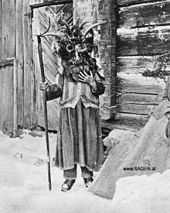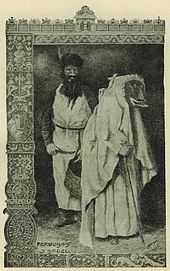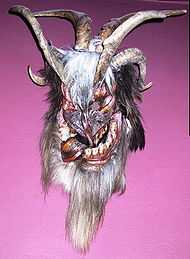Perchta


Perchta or Berchta (English: Bertha), also commonly known as Percht and other variations, was once known as a goddess in Southern Germanic paganism in the Alpine countries. Her name means "the bright one" (Old High German beraht, bereht, from Proto-Germanic *brehtaz) and is probably related to the name Berchtentag, meaning the feast of the Epiphany.
Perchta is often identified as stemming from the same Germanic goddess as Holda and other female figures of German folklore (see Frija-Frigg). According to Jacob Grimm and Lotte Motz, Perchta is Holda's southern cousin or equivalent, as they both share the role of "guardian of the beasts" and appear during the Twelve Days of Christmas when they oversee spinning.[1][2] In some descriptions, Perchta has two forms; she may appear either as beautiful and white as snow like her name, or elderly and haggard.
Grimm says Perchta or Berchta was known "precisely in those Upper German regions where Holda leaves off, in Swabia, in Alsace, in Switzerland, in Bavaria and Austria."[3] In Bavaria and German Bohemia, Perchta was often represented by St. Lucia.
Names of Perchta
Perchta had many different names depending on the era and region: Grimm listed the names Perahta and Berchte as the main names (in his heading), followed by Berchta and Frau Berchta in Old High German, as well as Behrta and Frau Perchta. In Baden, Swabia, Switzerland and Slovenian regions, she was often called Frau Faste (the lady of the Ember days) or Pehta or 'Kvaternica', in Slovene. Elsewhere she was known as Posterli, Quatemberca and Fronfastenweiber.[4]
In southern Austria, in Carinthia among the Slovenes, a male form of Perchta was known as Quantembermann, in German, or Kvaternik, in Slovene (the man of the four Ember days).[4] Grimm thought that her male counterpart or equivalent is Berchtold.[5]
Traditional narratives
According to Jacob Grimm (1835), Perchta was spoken of in Old High German in the 10th century as Frau Berchta and thought to be a white-robed female spirit. She was known as a goddess who oversaw spinning and weaving, like myths of Holda in Continental German regions. He believes she was the feminine equivalent of Berchtold, and she was sometimes the leader of the Wild Hunt.
In many old descriptions, Bertha had one large foot, sometimes called a goose foot or swan foot. Grimm thought the strange foot symbolizes she may be a higher being who could shapeshift to animal form.[6] He noticed Bertha with a strange foot exist in many languages (German "Berhte mit dem fuoze", French "Berthe au grand pied", Latin "Berhta cum magno pede"): "It is apparently a swan-maiden's foot, which as a mark of her higher nature she cannot lay aside...and at the same time the spinning-woman's splayfoot that worked the treadle".[7]
Bertha is reportedly angered if on her feast day, the traditional meal of fish and gruel is forgotten, and will slit people's bellies open and stuff them with straw if they eat something else that night.[3][8]
In the folklore of Bavaria and Austria, Perchta was said to roam the countryside at midwinter, and to enter homes between the twelve days between Christmas and Epiphany (especially on the Twelfth Night). She would know whether the children and young servants of the household had behaved well and worked hard all year. If they had, they might find a small silver coin next day, in a shoe or pail. If they had not, she would slit their bellies open, remove stomach and guts, and stuff the hole with straw and pebbles. She was particularly concerned to see that girls had spun the whole of their allotted portion of flax or wool during the year.[8]
Characterization
Perchta was at first a benevolent spirit. In Germanic paganism, Perchta had the rank of a minor deity. That changed to an enchanted creature (spirit or elf) in Old High German - such as Grimm describes - but she was given a more malevolent character (sorceress or witch) in later ages.[9]
The cult of Perchta was condemned in Bavaria by the Thesaurus pauperum (1468). It requested of its followers to leave food and drink for Fraw Percht and her followers, in exchange of wealth and abundance. The same practice was condemned by Thomas Ebendorfer von Haselbach in De decem praeceptis (1439).
Later canonical and church documents characterized Perchta as synonymous with other leading female spirits: Holda, Diana, Herodias, Richella and Abundia.
Urglaawe
In Urglaawe, Berchta is considered a major deity, particularly during the Yuletide celebrations of Elfder Daag (Eleventh Day) and Zwelfdi Nacht (Twelfth Night). Both of these celebrations fall on the current calendar date of December 31, which Grimm cites as her traditional Feast Day.[10][11] The name of the observance in Urglaawe is Berchtaslaaf.[12]
The perceptions of Berchta in Urlgaawe range from her being Holle by another name to her being Holle's sister, therefore placing her among the Wane. She is seen as a goddess who demand order in one's behavior and consciousness. Owls are seen as her sacred animal. The association between Berchta and owls also leads to the belief that owls are her messengers and that the presence of owls by the home can be warnings of danger or death. The association may also be related to the Eil (Owl) moon sign commonly falling around Yuletide on the Deitsch lunar zodiac (Muunraad). The Eil sign is the ninth new moon after the Oschdre (the vernal equinox).[13]
According to Grimm, Berchta also commands that certain meals be consumed and offered to her on her feast day. The meals consist of zemmede, herring and gruel, though variations do occur regionally. These food items are included in the Urglaawe Berchtaslaaf observances.[14][15]
Related beings

Grimm thinks Holda is her equivalent while the Weisse frauen may derive directly from Berchta in her white form.
The word Perchten is plural for Perchta, and this has become the name of her entourage, as well as the name of animal masks worn in parades and festivals in the mountainous regions of Austria. In the 16th century, the Perchten took two forms: Some are beautiful and bright, known as the Schönperchten ("beautiful Perchten"). These come during the Twelve Nights and festivals to "bring luck and wealth to the people." The other form is the Schiachperchten ("ugly Perchten") who have fangs, tusks and horse tails which are used to drive out demons and ghosts. Men dressed as the ugly Perchten during the 16th century and went from house to house driving out bad spirits.[16][17]
Sometimes, der Teufel is viewed to be the most schiach ("ugly") Percht (masculine singular of Perchten) and Frau Perchta to be the most schön ("beautiful") Percht (singular of Perchten).
Today the Perchten are still a traditional part of Salzburg and Austrian holidays and festivals (such as the Carnival Fastnacht). The wooden animal masks made for the festivals are today called Perchten.[17]
In Italy, Perchta is roughly equivalent with La Befana, who visits all the children of Italy on the night before 6 January to fill their socks with candy if they are good or a lump of coal if they are bad.[18]
See also
| Wikimedia Commons has media related to Perchta. |
- Befana
- Berchtoldstag
- Krampus
- Oliebol
- Pre-Christian Alpine traditions
- Swabian-Alemannic-Fastnacht
- Weisse Frauen
- Wild Hunt
Notes
- ↑ Grimm, 1835.
- ↑ Motz according to Hilton 1984.
- ↑ 3.0 3.1 Grimm, 1835:13:6.
- ↑ 4.0 4.1 Ginzburg.
- ↑ Grimm 1835:31:4.
- ↑ Grimm 1835:33:02.
- ↑ Grimm 1835:13:08.
- ↑ 8.0 8.1 Frazer 1920:240.
- ↑ Grimm 1835:17:7.
- ↑ Grimm 1835:13:6.
- ↑ Schreiwer, Robert L. and Ammerili Eckhart. A Dictionary of Urglaawe Terminology, p. 8. Bristol, PA: Deitscherei, 2012.
- ↑ Schreiwer 8
- ↑ Schreiwer 17
- ↑ Schreiwer 8
- ↑ Grimm 1835:13:6
- ↑ Frazer 1920:242-243
- ↑ 17.0 17.1 Wagner 2007.
- ↑ Illes, p. 269
References
- Frazer, Sir James George. 1920. The Golden Bough. A Study in Magic and Religion. IX. Part 6. "The Scapegoat", pages 240-243. MacMillian & Co. (Facsimili Elibron Classics, 2005) ISBN 1-4021-8348-8. (Online). File retrieved May 18, 2007.
- Grimm, Jacob (1835). Deutsche Mythologie (German Mythology); From English released version Grimm's Teutonic Mythology (1888); Available online by Northvegr © 2004-2007: Chapter 13, page 6;Chapter 13, page 8; Chapter 17, page 7;Chapter 31, page 4.
- Hilton, Edward. Winter Goddess (A Summary of Lotte Motz) (Online). File retrieved May 18, 2007.
- Motz, Lotte. 1984. The Winter Goddess, Folklore 95:11.
- Müller, Felix and Ulrich. 1999. Percht und Krampus, Kramperl und Schiach-Perchten. Wunderlich, Werner (Hrsg.): Mittelalter-Mythen 2. Dämonen-Monster-Fabelwesen. St. Gallen, S. 449-460. (Online, German) File retrieved May 18, 2007.
- Reginheim. 2002. Forgotten Gods. (Online). File retrieved 05-17-2007.
- Wagner, Alexander. 2007. Perchtenläufe: Salzburg's Pagan Heritage. (Online) File retrieved May 18, 2007.